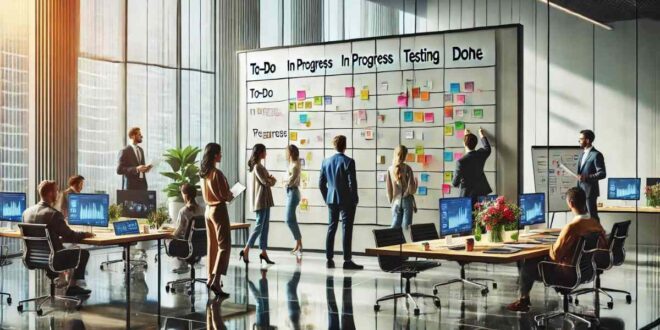Agile project management has become increasingly popular in modern workplaces due to its flexibility, adaptability, and emphasis on collaboration. At the heart of agile methodologies lies the use of visual tools to facilitate communication, transparency, and efficiency. Whiteboards are central to these tools, serving as dynamic canvases for planning, tracking, and optimizing project workflows. This article explores strategies for successfully integrating whiteboards into agile project management practices, empowering teams to achieve their goals with clarity and agility.
Visualizing Workflows with Kanban Boards
Kanban boards are a hallmark of agile project management, visually representing work items, tasks, and workflow stages. Here’s how to leverage whiteboards for effective Kanban implementation:
- Workflow Mapping: Use the whiteboard to map out the stages of your project workflow, from “To-Do” and “In Progress” to “Testing” and “Done,” creating a visual roadmap that guides the progression of tasks from start to finish.
- Task Visualization: On the whiteboards, represent individual tasks or user stories as cards, each moving across the board as they progress through various workflow stages. This provides a clear overview of work in progress and bottlenecks.
- Limiting Work in Progress (WIP): Implement WIP limits on each column of the Kanban board to prevent overloading team members and maintain a steady flow of work, ensuring that tasks are completed efficiently and without unnecessary delays.
Facilitating Daily Stand-Ups with Scrum Boards
Scrum boards are another staple of agile project management, facilitating daily stand-up meetings and sprint planning sessions. Here’s how to optimize whiteboards for Scrum practices:
· Sprint Planning: Divide the whiteboard into sections representing the backlog, sprint backlog, and sprint goals, allowing team members to visualize upcoming tasks, prioritize work items, and plan sprint objectives collaboratively.
· Daily Stand-Ups: Use the whiteboard as a focal point for daily stand-up meetings, with team members gathering around to discuss progress, identify impediments, and update task statuses by moving cards across the board as needed.
· Burndown Charts: Create burndown charts on the whiteboard to track sprint progress and visualize remaining work over time, enabling teams to monitor their velocity, adapt to changing priorities, and forecast project timelines more accurately.
Promoting Collaboration and Transparency
Whiteboards foster a culture of collaboration and transparency within agile teams, enabling real-time communication and collective problem-solving:
· Team Collaboration: Encourage active participation and engagement during whiteboard sessions, with team members sharing insights, offering feedback, and collaborating on solutions to challenges, fostering a sense of ownership and camaraderie.
· Transparency: Whiteboards provide a centralized repository of project information that is accessible to all team members, promoting transparency and visibility into progress, priorities, and dependencies, facilitating informed decision-making and alignment.
· Iterative Improvement: Use the whiteboard as a platform for continuous improvement, with teams regularly reflecting on their processes, identifying areas for optimization, and experimenting with new strategies to enhance productivity and delivery quality.
Conclusion
Whiteboards are invaluable tools in the agile project management toolkit, empowering teams to visualize workflows, facilitate communication, and foster collaboration in dynamic and fast-paced environments. By leveraging whiteboards effectively for Kanban and Scrum practices, teams can streamline their project workflows, optimize their sprint planning processes, and achieve their goals with clarity and agility. With a commitment to transparency, collaboration, and continuous improvement, organizations can harness the power of whiteboards to drive success in their agile endeavors and deliver value to their stakeholders with confidence.
Frequently Asked Questions (FAQs)
How do whiteboards enhance workflow visualization in agile projects?
Whiteboards provide a clear, visual representation of tasks as they move through different stages, making it easier for teams to track progress, identify bottlenecks, and maintain focus on priorities.
What is the role of whiteboards in daily stand-up meetings?
During daily stand-ups, whiteboards are a central point for updating task statuses, discussing progress, and addressing obstacles. This keeps the team aligned and informed.
How can teams use whiteboards for effective sprint planning?
Whiteboards can be divided into sections for the product backlog, sprint backlog, and sprint goals. This setup allows teams to collaboratively prioritize tasks, allocate them to the sprint, and visualize the work ahead.
What are the benefits of using whiteboards to create burndown charts?
Creating burndown charts on a whiteboard helps teams track the remaining work in a sprint, monitor their progress, and adjust their efforts to meet sprint goals more accurately.
How do whiteboards contribute to team collaboration and transparency?
Whiteboards encourage active participation during sessions, promote transparency by making project information accessible to everyone, and foster a collaborative environment where team members can share insights and solve problems together.
Can whiteboards be used for continuous improvement in agile practices?
Yes, teams can use whiteboards during retrospectives to reflect on their processes, identify areas for improvement, and experiment with new strategies to enhance productivity and delivery quality in future sprints.





I don’t think the title of your article matches the content lol. Just kidding, mainly because I had some doubts after reading the article.
I don’t think the title of your article matches the content lol. Just kidding, mainly because I had some doubts after reading the article.